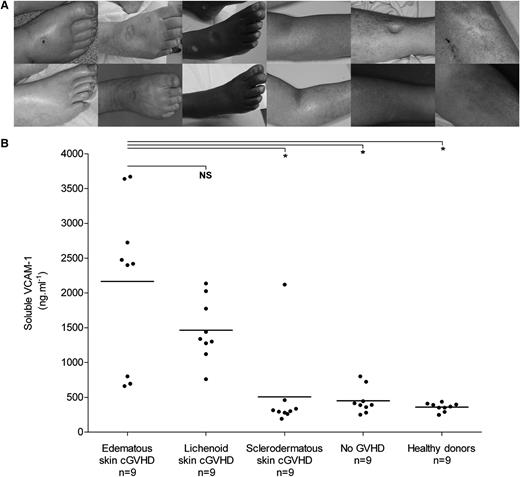To the editor:
Chronic graft-versus-host disease (cGVHD) is an allo-immune reaction against recipient organs after allogeneic hematopoietic stem cell transplantation (AHSCT).1 Clinical forms of skin cGVHD are mainly described as lichenoid and sclerodermatous.2-4 Localized edema as a particular form of skin cGVHD has never been described. We observed 9 cases of localized edema with rapid sclerodermatous evolution after AHSCT. Medical charts were retrospectively analyzed for these 9 patients. Because there is increasing evidence that the endothelium is a target in cGVHD,5-7 we hypothesized that the localized edema was associated with endothelial injury. Plasma levels of soluble vascular adhesion molecule-1 (sVCAM-1), a molecule secreted on endothelial activation,8 were retrospectively analyzed. Median time of edema apparition after AHSCT was 31 months (range, 5-72 months). In all patients, systemic or cutaneous cGVHD was associated with edema: bronchiolitis obliterans, (n = 5), liver cGVHD (n = 5), digestive cGVHD, (n = 1), muscle cGVHD (n = 2), lichenoid skin cGVHD (n = 3), sclerodermatous cGVHD (n = 2), and mucosal cGVHD (n = 5). Common causes of edema, including venous thrombosis, were ruled out. Skin biopsy, performed in 3 patients, was normal in 1 case, showed edema of the dermis associated with lichenoid changes of the basal layer in 1 case, and showed slight inflammatory infiltrate of the dermis in 1 case. Evolution toward localized skin sclerosis was noted in 9 cases (Figure 1A). Increasing the dose of oral steroids induced edema remission but did not prevent sclerosis in 7 cases. Extracorporeal photochemotherapy plus steroids decreased edema but did not prevent sclerosis in 1 patient. Sirolimus associated with steroids allowed complete regression of the edema, and slight sclerosis of the affected limb was noted during follow-up in 1 patient. The diagnosis of edematous cGVHD is supported by the absence of alternate etiologies for edema, the association with cutaneous or extracutaneous cGVHD signs, the efficacy of immunosuppressive therapies, and the evolution toward sclerodermatous cGVHD. To investigate a possible mechanism of edema in this setting, we measured circulating sVCAM-1 levels in our patients (Figure 1B). The mean sVCAM-1 concentration in cases of edematous cGVHD was 2165 ± 964 ng/mL compared with 505 ± 358 ng/mL in cases of sclerodermatous cGVHD (P < .01), 1463 ± 343 ng/mL in cases of lichenoid cGVHD (P = .13), 450 ± 139 ng/mL in allograft patients without cGVHD (P < .01), and 360 ± 40 ng/mL in healthy donors (P < .01). Limitations of our study include the low number of edematous cGVHD patients, the overlap with other cGVHD lesions, and the variability in the sVCAM-1 levels in the 9 patients analyzed. This variability may be explained by inhomogeneous timing of sample collection in this retrospective study. However, our results suggest that endothelial activation in edematous and lichenoid skin cGVHD may be the first phase of a complex process leading to skin fibrosis. The same mechanism is suspected in eosinophilic fasciitis (a form of autoimmune localized skin scleroderma described outside the AHSC setting),9 where pitting edema may precede skin sclerosis.10 In conclusion, this newly described form of edematous skin cGVHD should be recognized by the clinician.
Clinical pictures and sVCAM-1 plasma levels in patients with edematous skin cGVHD. (A) Clinical pictures of 6 patients: (upper) inflammatory pitting edema and (lower) sclerodermatous evolution during follow-up. (B) Increased plasma sVCAM-1 levels in patients with edematous and lichenoid cGVHD. Scatter plots show plasma sVCAM-1 concentrations as measured by enzyme-linked immunosorbent assay in 9 patients with edematous skin cGVHD, 9 patients with lichenoid skin cGVHD, 9 patients with sclerodermatous skin cGVHD, 9 patients with hematopoietic stem cell transplantation but no cGVHD, and 9 healthy donors. Each dot represents an individual subject, and horizontal bars represent group means. Significant differences between group means are indicated: *P < .01 (Mann-Whitney nonparametric test).
Clinical pictures and sVCAM-1 plasma levels in patients with edematous skin cGVHD. (A) Clinical pictures of 6 patients: (upper) inflammatory pitting edema and (lower) sclerodermatous evolution during follow-up. (B) Increased plasma sVCAM-1 levels in patients with edematous and lichenoid cGVHD. Scatter plots show plasma sVCAM-1 concentrations as measured by enzyme-linked immunosorbent assay in 9 patients with edematous skin cGVHD, 9 patients with lichenoid skin cGVHD, 9 patients with sclerodermatous skin cGVHD, 9 patients with hematopoietic stem cell transplantation but no cGVHD, and 9 healthy donors. Each dot represents an individual subject, and horizontal bars represent group means. Significant differences between group means are indicated: *P < .01 (Mann-Whitney nonparametric test).
Authorship
Contribution: M.T. and J.-D.B. analyzed the results and wrote the paper; M.T., M. Rybojad, A.X., R.P.d.L., M. Robin, A.d.M., N.P., F.S.d.F., A. Bergeron, M.B., G.S., and J.-D.B provided patient care and helped to collect the data; J.-D.B. and H.L.B. performed experiments and analysis; C.S., A. Bensussan, and V.D. provided the study materials and contributed to the conception and design; and J.-D.B., M. Rybojad, A. Bensussan, M.B., and G.S. reviewed the paper and supervised the study.
Conflict-of-interest disclosure: The authors declare no competing financial interests.
Correspondence: Jean-David Bouaziz, Service de Dermatologie, Hôpital Saint-Louis, 1 Avenue Claude Vellefaux, 75010 Paris, France; e-mail: jean-david.bouaziz@sls.aphp.fr.


This feature is available to Subscribers Only
Sign In or Create an Account Close Modal